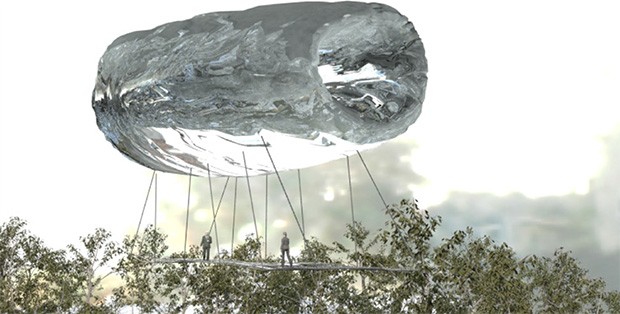The futuristic vision of 4 undergrads

The innovative design of four undergrads from Concordia’s Department of Design and Computation Arts outshone all but one of 60 teams in last week's 20th Interuniversity Charrette, a contest for young designers.
Organised by the Canadian Centre for Architecture and Université du Québec à Montréal, the competition is open to students and recent graduates in architecture, landscape architecture, environmental design, urban design, planning, industrial design and graphic design.
This year's edition asked participants to explore possible futures for Montreal’s Île Sainte-Hélène and Île Notre-Dame.
Teams of between three and five members were invited to create a site proposal for Montreal’s archipelago half a century from today. They were given four days to brainstorm, develop and produce two digital panels containing their designs.
Final-year design students Steven Steffen, Nick Castonguay, Gustavo Lopez Riveros and computation arts student Nima Navab earned second place among all the entries with their Cummulus Sanctuary project.
“Our design for the archipelago was somewhere between pragmatic, speculative and playful,” says Navab. “We were looking at how to use processing materials that purify water and air, and having these systems be the skin or the envelope of our structure.”
Riveros says the wrinkle in this year’s contest — which required students to reflect on the history of the two neighbouring islands, with Expo 67 in mind, then to think of new possibilities for the archipelago 50 years from today — made it a lot more fun.
“Because we were coming to it from a different perspective we were able to let our imaginations rule," he says. "We didn’t get stuck in the minutia. We were able to go beyond the physical building or structure and think about the interactive aspects of design.”
In the end, the team envisioned a balloon-like structure — built from a fluid net material — affixed to suspended walkways linking sites on the island. The cloud component would serve the double function of keeping the walkways afloat while also purifying the air and offering pedestrians a unique break from the natural landscape, as well as great views of the island.

Carmela Cucuzzella, a professor in the Department of Design and Computation Arts says the Concordia team's exceptional performance is extra meaningful given her students were competing against a lot of students with backgrounds in architecture — many of whom, she notes, had already graduated with their master’s degrees.
“It's an amazing feat for our university, and our students,” says Cucuzzella. “They felt a little overwhelmed and intimidated that they were surrounded by architects, but they went through with the challenge. They didn't give up.”
Cucuzzella says this speaks to Concordia’s interdisciplinary approach to teaching.
“Because we have a broad-based design program that teaches students to think critically and question socio-cultural assumptions, we are teaching them how to think outside the box," she says. "Our students were capable of addressing the Charrette challenge and able to finish strong, despite not being trained as architects.”
Steffen agrees. “It was validating to see that what we were doing was in fact relevant and that our studies in design and computation arts could be applied to an architecture problem," he says.
“Through employing the general approach to problem solving that’s taught within the design program, we were able to address the Charrette problem from a wider perspective and handle it in the same way we would an interactive design or computation art challenge. It was really cool.”
Concordia was one of eight universities to compete, including Université du Québec à Montréal, McGill University, Université de Montréal, Université Laval, Carleton University, Ryerson University and University of Toronto.
Besides bragging rights, the team received CCA books and a free membership to the CCA's international network of Friends.
Find out more about Concordia’s Design and Computation Arts Program.